
San Valentino is a Roman Catholic parish church, located near Piazzale Vittorio Veneto in the town of Bussolengo, province of Verona, region of Veneto, Italy.

San Valentino is a Roman Catholic parish church, located near Piazzale Vittorio Veneto in the town of Bussolengo, province of Verona, region of Veneto, Italy.
A church at the site was likely present by the 13th century, since documents once in the church of Santa Maria Maggiore of Bussolengo, state that in 1339, a Gilberto, bishop of Tiberiade, had reconsecrated the church after it had been sacked by soldiers fighting the Scaligeri forces. In 1391, the bishop of Verona, Giacomo de Rossi, granted the flagellant confraternity of the Disciplini the right to restore the church, and construct an adjacent hostel for travellers. By the first half of the 15th century the church had been frescoed by anonymous local painters with a cycle of frescoes narrating the Life of St Valentine . On the south portico of the church is a 14th-century fresco of the Crucifixion. By the end of the 16th century, the church had one main altar and three minor ones dedicated respectively to the Blessed Virgin, the Pietà, and St James.
In 2011, the interior and exterior underwent restoration. [1]

Padua ; Venetian: Pàdova, Pàdoa or Pàoa) is a city and commune in Veneto, northern Italy. Padua is on the river Bacchiglione, west of Venice. It is the capital of the province of Padua. It is also the economic and communications hub of the area. Padua's population is 214,000. The city is sometimes included, with Venice and Treviso, in the Padua-Treviso-Venice Metropolitan Area (PATREVE) which has a population of around 2,600,000.

Verona ; Venetian: Verona or Veròna) is a city on the Adige River in Veneto, Italy, with 258,031 inhabitants. It is one of the seven provincial capitals of the region, and is the largest city municipality in the region and in northeastern Italy. The metropolitan area of Verona covers an area of 1,426 km2 (550.58 sq mi) and has a population of 714,310 inhabitants. It is one of the main tourist destinations in Northern Italy because of its artistic heritage and several annual fairs and shows as well as the opera season in the Arena, an ancient Roman amphitheater.
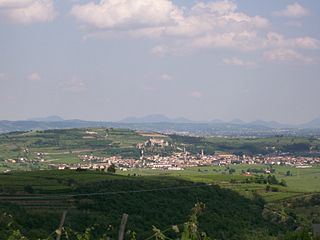
Soave is a small comune of the Veneto region in the Province of Verona, northern Italy, with a population of roughly 6,800 people.

Bussolengo is an Italian town of 19,574 inhabitants on the Adige River in province of Verona, Veneto. One of its oldest churches is the frescoed church of San Valentino.

Albaredo d'Adige is a comune (municipality) in the Province of Verona in the Italian region Veneto, located about 80 kilometres (50 mi) west of Venice and about 25 kilometres (16 mi) south of Verona. It is located on the river Adige. As of 2004, it had a population of 5,138 and an area of 28.2 square kilometres (10.9 sq mi).

Bardolino is a comune (municipality) in the Province of Verona in the Italian region Veneto, located about 130 kilometres (81 mi) west of Venice and about 25 kilometres (16 mi) northwest of Verona.
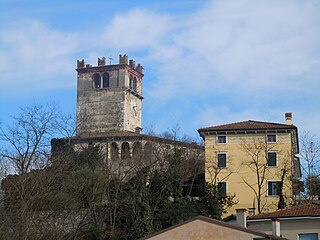
Castelnuovo del Garda is an Italian comune (municipality), in the Province of Verona, in Veneto, on a couple of morainic hills few kilometers south-east from Lake Garda. Verona is about 20 km to the east, Venice is 140 km east and Milan 140 km west.

Lazise is a comune (municipality) and town in the Province of Verona in the Italian region Veneto, located about 120 kilometres west of Venice and about 20 kilometres northwest of Verona. It is situated on the eastern shore of Lake Garda. As of 31 December 2004, it had a population of 6,213 and an area of 65.0 square kilometres (25.1 sq mi). This geographical location empowers a position of great landscape value, but it also features elements of great architectural value and of great historical importance.

Monteforte d'Alpone is a comune (municipality) in the Province of Verona in the Italian region Veneto, located about 80 kilometres (50 mi) west of Venice and about 25 kilometres (16 mi) east of Verona.
Pastrengo is a comune (municipality) in the Province of Verona in the Italian region Veneto, located about 120 kilometres (75 mi) west of Venice and about 15 kilometres (9 mi) northwest of Verona. As of 31 December 2004, it had a population of 2,486 and an area of 9.0 square kilometres (3.5 sq mi).

Pescantina is a comune (municipality) in the Province of Verona in the Italian region Veneto, located about 110 kilometres (68 mi) west of Venice and about 11 kilometres (7 mi) northwest of Verona. As of 31 December 2004, it had a population of 14,096 and an area of 19.7 square kilometres (7.6 sq mi).
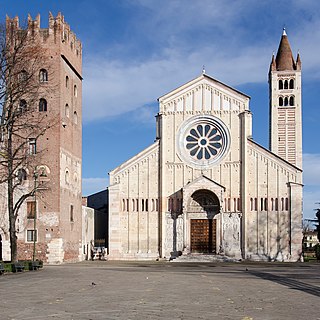
The Basilica di San Zeno is a minor basilica of Verona, northern Italy constructed between 967 and 1398 AD. Its fame rests partly on its Romanesque architecture and partly upon the tradition that its crypt was the place of the marriage of Shakespeare's Romeo and Juliet. It stands adjacent to a Benedictine abbey, both dedicated to St Zeno of Verona.

The chiesa di Sant'Anastasia, or the Basilica of Saint Anastasia is a church built by the Dominican Order in Verona, northern Italy. In Gothic style, it is the largest church in the city, located in its most ancient district, near the Ponte Pietra.

San Giorgio in Braida is a Roman Catholic church in Verona, region of Veneto, Italy. A church titled San Giacomo in Braida, was located in Cremona, and became superseded by Sant'Agostino.

San Bernardino is a church in Verona, northern Italy. The church, in Gothic style, was built from 1451 to 1466.
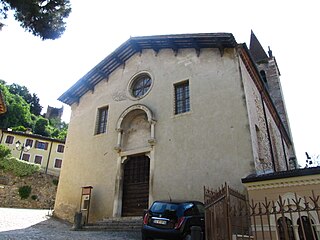
Santa Maria dei Domenicani is a small, 15th-century, Roman Catholic church, located inside the Scaliger walls near Piazza dell’Antenna in Soave, province of Verona, region of Veneto, Italy.

The church of Sant'Eufemia is Gothic-style, Roman Catholic church in Verona, region of Veneto, Italy.

San Procolo is a Paleo-Christian, Roman Catholic small temple standing adjacent to the Basilica di San Zeno in central Verona, region of Veneto, Italy.
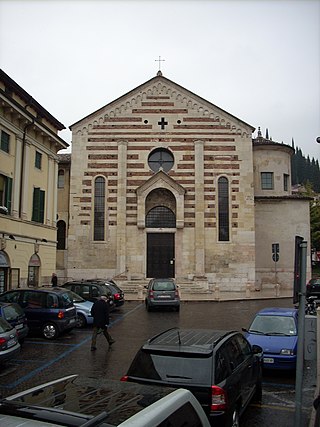
Santo Stefano is a Paleo-Christian, Roman Catholic basilica church in central Verona, region of Veneto, Italy.

Santa Maria in Chiavica is a former Roman Catholic church, now deconsecrated, in the Renaissance style, located on Via S. Maria in Chiavica number 7 in central Verona, region of Veneto, Italy. The building retains portions of its original Romanesque structure and original fresco and altar decoration, but is now used for theatrical and musical performances.